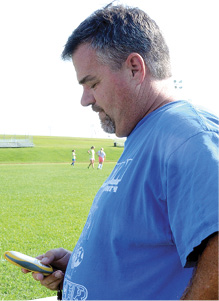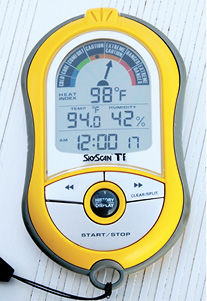Bad weather can bring outdoor sports to a halt – and so can extreme heat

Technology use keeps high school athletes safer

Above, C.C.H.S. soccer coach Greg Cummings checks the heat index monitor during a recent practice.
During the final two week’s of August, temperatures, as well as humidity have soared to extreme levels.
The heat index has been well over 100 degrees several days during the month of August and coaches of high school teams playing their sports outside have to keep a close eye on the heat index in order to play or practice.
Rules that deal with the heat index are put into play by the Kentucky High School Athletic Association. Each coach for soccer, cross country, golf and football has to watch closely in order to abide by these rules and to keep their players from overheating during the late summer months.
Before the final two weeks of August, most coaches said they haven’t had to worry about the heat index, but several times last week, practices were amended in order to give players more water breaks throughout practice and game time.
Head boys’ soccer coach Greg Cummings said they haven’t had to cancel practices or games yet, but they have had to change the format of the games in order to accommodate the heat index rules.
“We had one game started later and we did quarters instead of halves,” Cummings said.
The soccer teams normally play two 40 minute-halves, but during a game last week, the game was set up to have four 20 minute-quarters with a 10-minutes break in between each quarter to allow for players to cool down.
“It’s real tough on them because they are running all the time,” Cummings said. “Whoever has the home field, they have to carry a heat index monitor and show the official throughout the game in order to continue playing.”
Cummings said the referees are really good about watching players and they can tell when a player needs a break during the game.
“They usually tell us when a kid needs to take a break, so we run them in and out pretty often,” Cummings said.
The rules for heat index are as follows:
If the heat index is above 104, all sports are required to stop all outside activity, including practices and playing games and stop all inside activity if air conditioning is unavailable.
If the heat index is above 99 degrees and below 104 degrees, all sports should make water available and athletes should be able to take in as much water as they desire. Mandatory water breaks every 30 minutes for 10 minutes are required and towels with ice shall be provided if needed.
Teams are also recommended to alter their uniform, for example, football can remove pads and helmets in order to keep players cooler during practices.
Coaches also have the choice to postpone practice or games until later in the day and they have to re-check temperature and humidity every 30 minutes to monitor for changes in the heat index.
If the heat index is 95 degrees to 99 degrees, the same rules apply concerning water breaks and providing towels and ice for players. For contact sports, helmets and other equipment should be removed when an athlete is not directly involved with competition, drill or practice and is not otherwise required by rule.
Coaches should consider postponing practice or reducing the time of outside activity.
For days under 95 degree heat index, all previous water rules apply, but equipment regulations are not monitored as closely. Full contact sports are able to practice or play with full equipment when the heat index is under 95 degrees.
Clinton County High School Athletic Director Mike Beard said when the temperature is above 80 degrees, each coach has to keep a record that includes, date, time, temperature, heat index and what revisions each coach has made during practice to abide by the heat index rules.
Other than soccer and football, cross country has been affected by the high heat index during the past two week.
Cross Country Head Coach Dipesh Soma said they have had to move several practices indoors.
“I’ve had to move practice indoors and that hinders what I can do,” Soma said. “We are on a set schedule now, but I did have to move practices to 7 p.m. in order to get practices in. I’m thankful the Wellness Center is there, so we can move inside if we have to. They take it serious, which is good.”
Soma said one day last week the heat index meter read 115 degrees, but he went to another source that said it was 110, both well above the outside activity cut off of 104 degrees.
Soma’s first meet was last Thursday at Green County and he said they already pushed the meet back to 5:30 p.m. from a previous 4 p.m. start.
“They also shorten the race because of the heat,” Soma said. “Normally the race is 3.1 miles, but it will be 1.8 miles which still counts as a varsity run, but it helps with the heat and keeps them from overheating while running.”

A close-up look at the data provided by the monitors.


